Commentary on a Public Health Brochure for Tender Trap Restaurant
VerifiedAdded on 2020/04/01
|6
|1385
|337
Report
AI Summary
This report is a commentary on a public health brochure created by Tender Trap restaurant to educate the public about food safety and hygiene. The brochure addresses the high incidence of food poisoning in Australia and the importance of safe food handling practices in restaurants. It highlights the restaurant's commitment to food safety and its recognition in "The Age Good Food Guide." The brochure's target audience includes frequent diners and restaurant owners, with the goal of raising awareness about food safety standards. The commentary analyzes the brochure's content, design, and distribution strategy, emphasizing the use of color, informal fonts, and targeted distribution to maximize its impact. The report underscores the importance of the initiative in improving the food habits of Australian citizens and promoting the restaurant. The report also references various studies and publications related to food safety, public health, and consumer behavior in the restaurant industry.
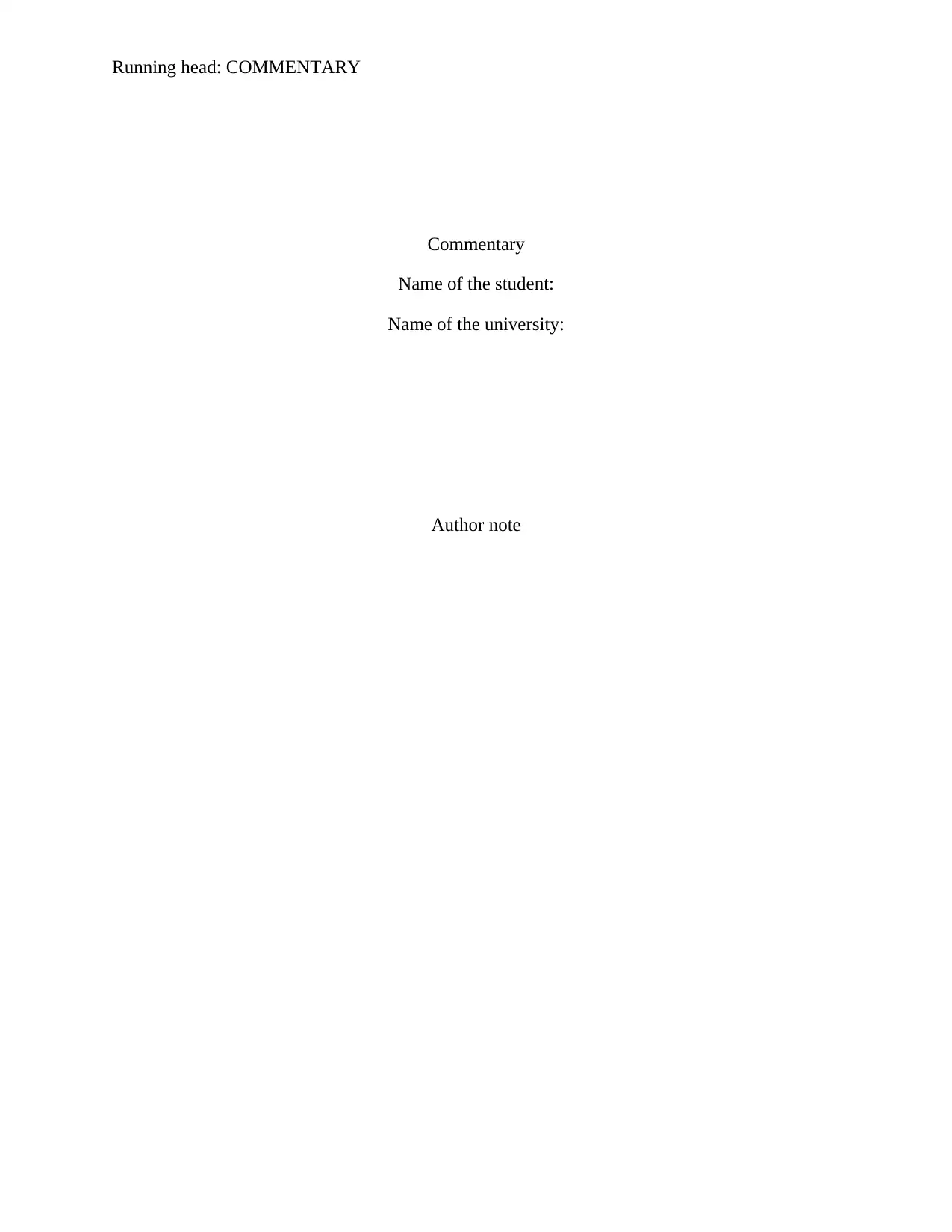
Running head: COMMENTARY
Commentary
Name of the student:
Name of the university:
Author note
Commentary
Name of the student:
Name of the university:
Author note
Paraphrase This Document
Need a fresh take? Get an instant paraphrase of this document with our AI Paraphraser
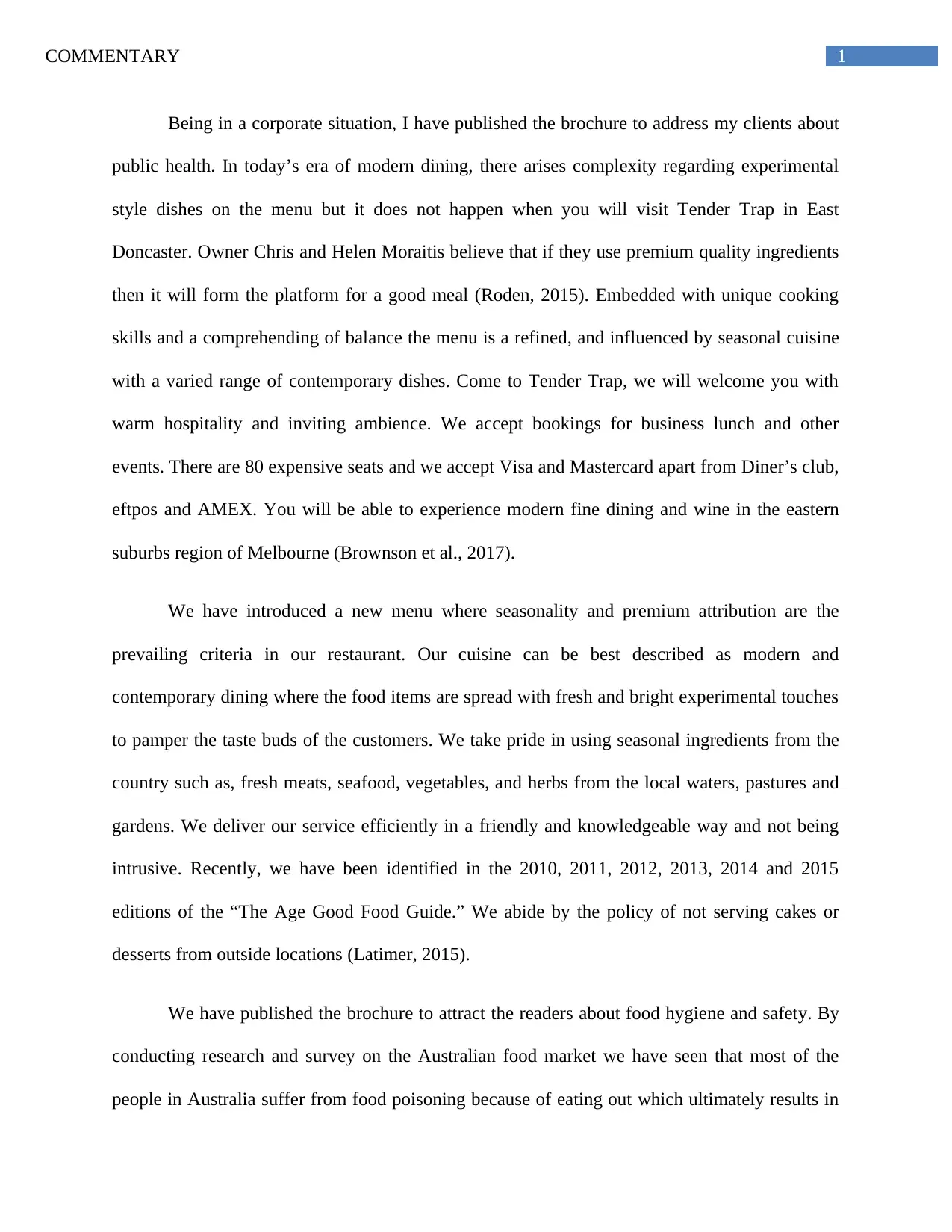
1COMMENTARY
Being in a corporate situation, I have published the brochure to address my clients about
public health. In today’s era of modern dining, there arises complexity regarding experimental
style dishes on the menu but it does not happen when you will visit Tender Trap in East
Doncaster. Owner Chris and Helen Moraitis believe that if they use premium quality ingredients
then it will form the platform for a good meal (Roden, 2015). Embedded with unique cooking
skills and a comprehending of balance the menu is a refined, and influenced by seasonal cuisine
with a varied range of contemporary dishes. Come to Tender Trap, we will welcome you with
warm hospitality and inviting ambience. We accept bookings for business lunch and other
events. There are 80 expensive seats and we accept Visa and Mastercard apart from Diner’s club,
eftpos and AMEX. You will be able to experience modern fine dining and wine in the eastern
suburbs region of Melbourne (Brownson et al., 2017).
We have introduced a new menu where seasonality and premium attribution are the
prevailing criteria in our restaurant. Our cuisine can be best described as modern and
contemporary dining where the food items are spread with fresh and bright experimental touches
to pamper the taste buds of the customers. We take pride in using seasonal ingredients from the
country such as, fresh meats, seafood, vegetables, and herbs from the local waters, pastures and
gardens. We deliver our service efficiently in a friendly and knowledgeable way and not being
intrusive. Recently, we have been identified in the 2010, 2011, 2012, 2013, 2014 and 2015
editions of the “The Age Good Food Guide.” We abide by the policy of not serving cakes or
desserts from outside locations (Latimer, 2015).
We have published the brochure to attract the readers about food hygiene and safety. By
conducting research and survey on the Australian food market we have seen that most of the
people in Australia suffer from food poisoning because of eating out which ultimately results in
Being in a corporate situation, I have published the brochure to address my clients about
public health. In today’s era of modern dining, there arises complexity regarding experimental
style dishes on the menu but it does not happen when you will visit Tender Trap in East
Doncaster. Owner Chris and Helen Moraitis believe that if they use premium quality ingredients
then it will form the platform for a good meal (Roden, 2015). Embedded with unique cooking
skills and a comprehending of balance the menu is a refined, and influenced by seasonal cuisine
with a varied range of contemporary dishes. Come to Tender Trap, we will welcome you with
warm hospitality and inviting ambience. We accept bookings for business lunch and other
events. There are 80 expensive seats and we accept Visa and Mastercard apart from Diner’s club,
eftpos and AMEX. You will be able to experience modern fine dining and wine in the eastern
suburbs region of Melbourne (Brownson et al., 2017).
We have introduced a new menu where seasonality and premium attribution are the
prevailing criteria in our restaurant. Our cuisine can be best described as modern and
contemporary dining where the food items are spread with fresh and bright experimental touches
to pamper the taste buds of the customers. We take pride in using seasonal ingredients from the
country such as, fresh meats, seafood, vegetables, and herbs from the local waters, pastures and
gardens. We deliver our service efficiently in a friendly and knowledgeable way and not being
intrusive. Recently, we have been identified in the 2010, 2011, 2012, 2013, 2014 and 2015
editions of the “The Age Good Food Guide.” We abide by the policy of not serving cakes or
desserts from outside locations (Latimer, 2015).
We have published the brochure to attract the readers about food hygiene and safety. By
conducting research and survey on the Australian food market we have seen that most of the
people in Australia suffer from food poisoning because of eating out which ultimately results in
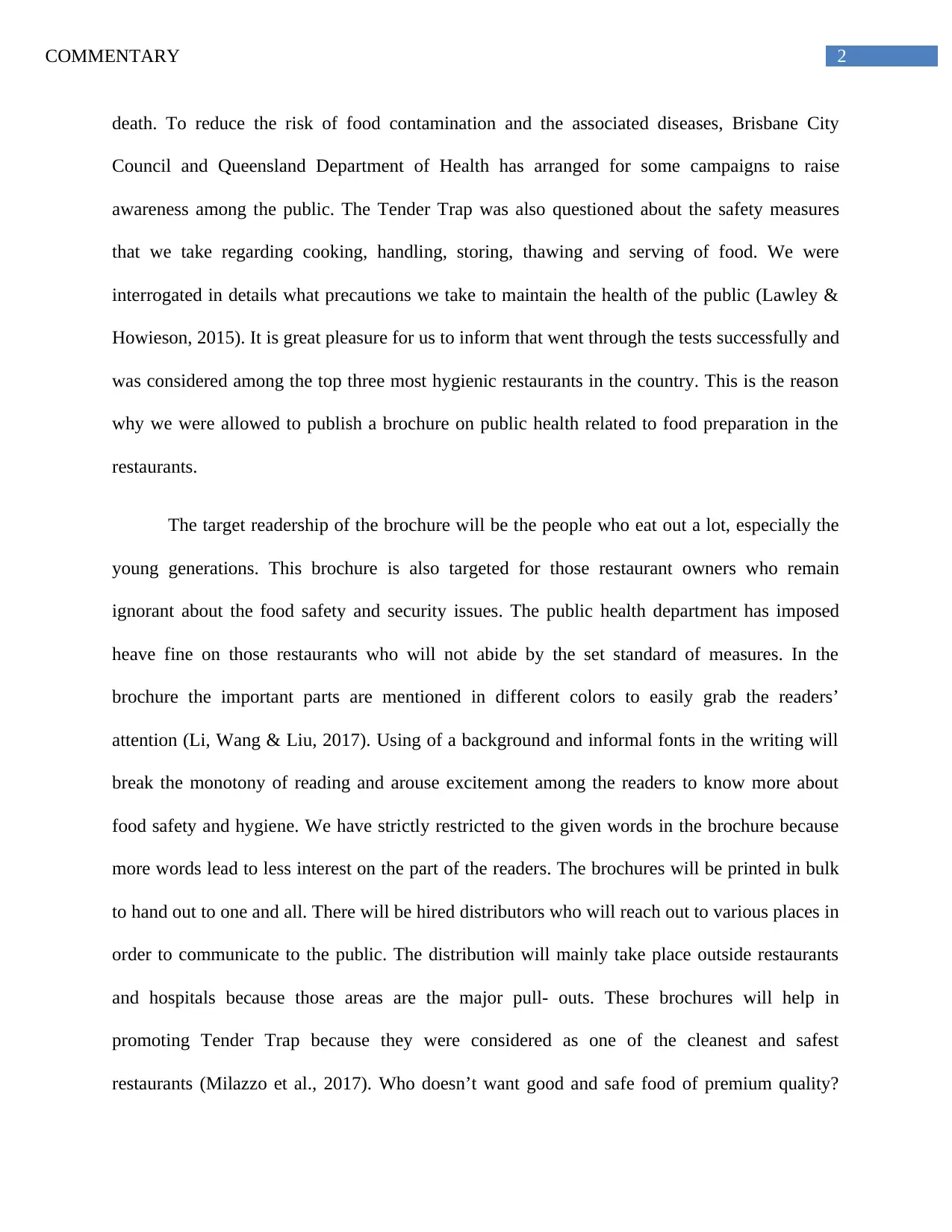
2COMMENTARY
death. To reduce the risk of food contamination and the associated diseases, Brisbane City
Council and Queensland Department of Health has arranged for some campaigns to raise
awareness among the public. The Tender Trap was also questioned about the safety measures
that we take regarding cooking, handling, storing, thawing and serving of food. We were
interrogated in details what precautions we take to maintain the health of the public (Lawley &
Howieson, 2015). It is great pleasure for us to inform that went through the tests successfully and
was considered among the top three most hygienic restaurants in the country. This is the reason
why we were allowed to publish a brochure on public health related to food preparation in the
restaurants.
The target readership of the brochure will be the people who eat out a lot, especially the
young generations. This brochure is also targeted for those restaurant owners who remain
ignorant about the food safety and security issues. The public health department has imposed
heave fine on those restaurants who will not abide by the set standard of measures. In the
brochure the important parts are mentioned in different colors to easily grab the readers’
attention (Li, Wang & Liu, 2017). Using of a background and informal fonts in the writing will
break the monotony of reading and arouse excitement among the readers to know more about
food safety and hygiene. We have strictly restricted to the given words in the brochure because
more words lead to less interest on the part of the readers. The brochures will be printed in bulk
to hand out to one and all. There will be hired distributors who will reach out to various places in
order to communicate to the public. The distribution will mainly take place outside restaurants
and hospitals because those areas are the major pull- outs. These brochures will help in
promoting Tender Trap because they were considered as one of the cleanest and safest
restaurants (Milazzo et al., 2017). Who doesn’t want good and safe food of premium quality?
death. To reduce the risk of food contamination and the associated diseases, Brisbane City
Council and Queensland Department of Health has arranged for some campaigns to raise
awareness among the public. The Tender Trap was also questioned about the safety measures
that we take regarding cooking, handling, storing, thawing and serving of food. We were
interrogated in details what precautions we take to maintain the health of the public (Lawley &
Howieson, 2015). It is great pleasure for us to inform that went through the tests successfully and
was considered among the top three most hygienic restaurants in the country. This is the reason
why we were allowed to publish a brochure on public health related to food preparation in the
restaurants.
The target readership of the brochure will be the people who eat out a lot, especially the
young generations. This brochure is also targeted for those restaurant owners who remain
ignorant about the food safety and security issues. The public health department has imposed
heave fine on those restaurants who will not abide by the set standard of measures. In the
brochure the important parts are mentioned in different colors to easily grab the readers’
attention (Li, Wang & Liu, 2017). Using of a background and informal fonts in the writing will
break the monotony of reading and arouse excitement among the readers to know more about
food safety and hygiene. We have strictly restricted to the given words in the brochure because
more words lead to less interest on the part of the readers. The brochures will be printed in bulk
to hand out to one and all. There will be hired distributors who will reach out to various places in
order to communicate to the public. The distribution will mainly take place outside restaurants
and hospitals because those areas are the major pull- outs. These brochures will help in
promoting Tender Trap because they were considered as one of the cleanest and safest
restaurants (Milazzo et al., 2017). Who doesn’t want good and safe food of premium quality?
⊘ This is a preview!⊘
Do you want full access?
Subscribe today to unlock all pages.

Trusted by 1+ million students worldwide
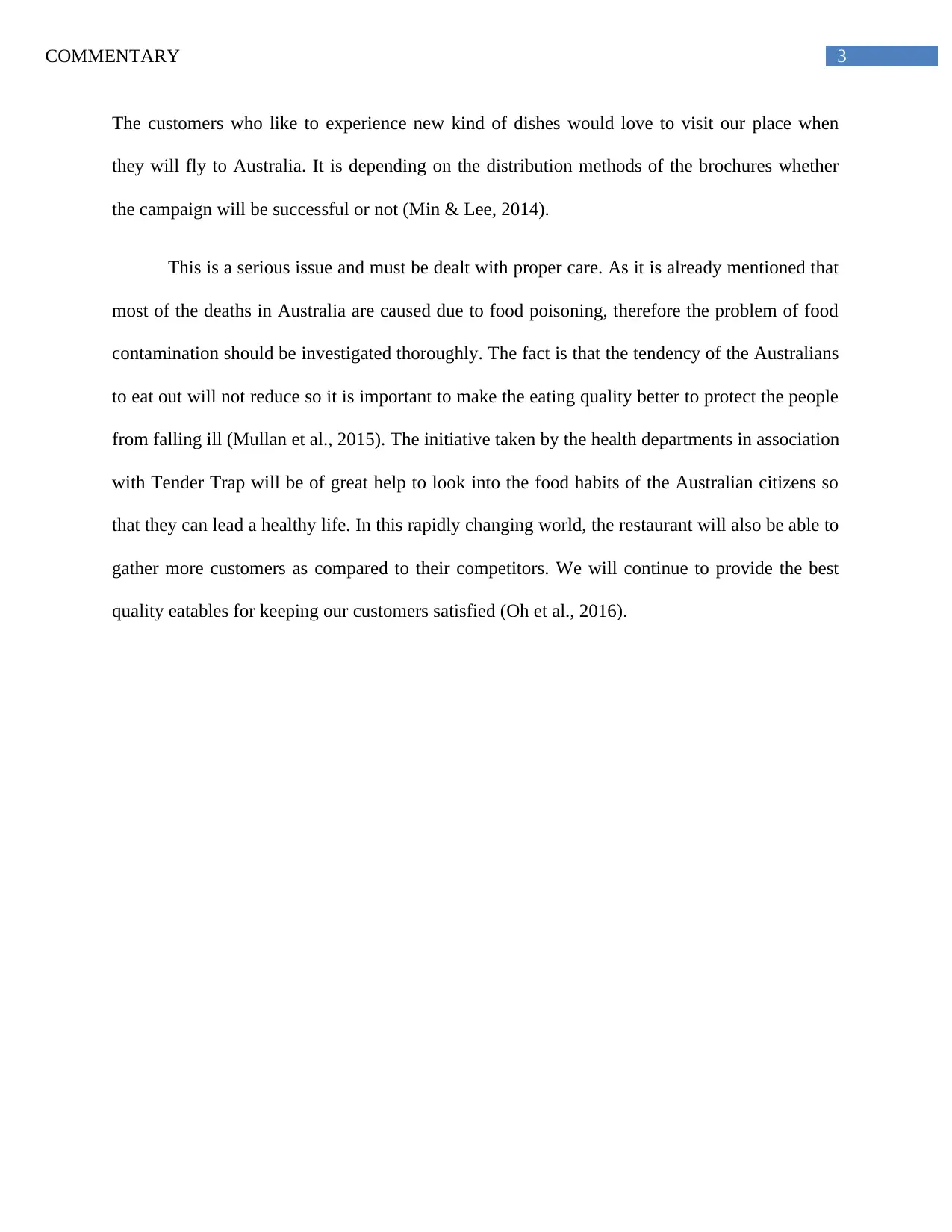
3COMMENTARY
The customers who like to experience new kind of dishes would love to visit our place when
they will fly to Australia. It is depending on the distribution methods of the brochures whether
the campaign will be successful or not (Min & Lee, 2014).
This is a serious issue and must be dealt with proper care. As it is already mentioned that
most of the deaths in Australia are caused due to food poisoning, therefore the problem of food
contamination should be investigated thoroughly. The fact is that the tendency of the Australians
to eat out will not reduce so it is important to make the eating quality better to protect the people
from falling ill (Mullan et al., 2015). The initiative taken by the health departments in association
with Tender Trap will be of great help to look into the food habits of the Australian citizens so
that they can lead a healthy life. In this rapidly changing world, the restaurant will also be able to
gather more customers as compared to their competitors. We will continue to provide the best
quality eatables for keeping our customers satisfied (Oh et al., 2016).
The customers who like to experience new kind of dishes would love to visit our place when
they will fly to Australia. It is depending on the distribution methods of the brochures whether
the campaign will be successful or not (Min & Lee, 2014).
This is a serious issue and must be dealt with proper care. As it is already mentioned that
most of the deaths in Australia are caused due to food poisoning, therefore the problem of food
contamination should be investigated thoroughly. The fact is that the tendency of the Australians
to eat out will not reduce so it is important to make the eating quality better to protect the people
from falling ill (Mullan et al., 2015). The initiative taken by the health departments in association
with Tender Trap will be of great help to look into the food habits of the Australian citizens so
that they can lead a healthy life. In this rapidly changing world, the restaurant will also be able to
gather more customers as compared to their competitors. We will continue to provide the best
quality eatables for keeping our customers satisfied (Oh et al., 2016).
Paraphrase This Document
Need a fresh take? Get an instant paraphrase of this document with our AI Paraphraser
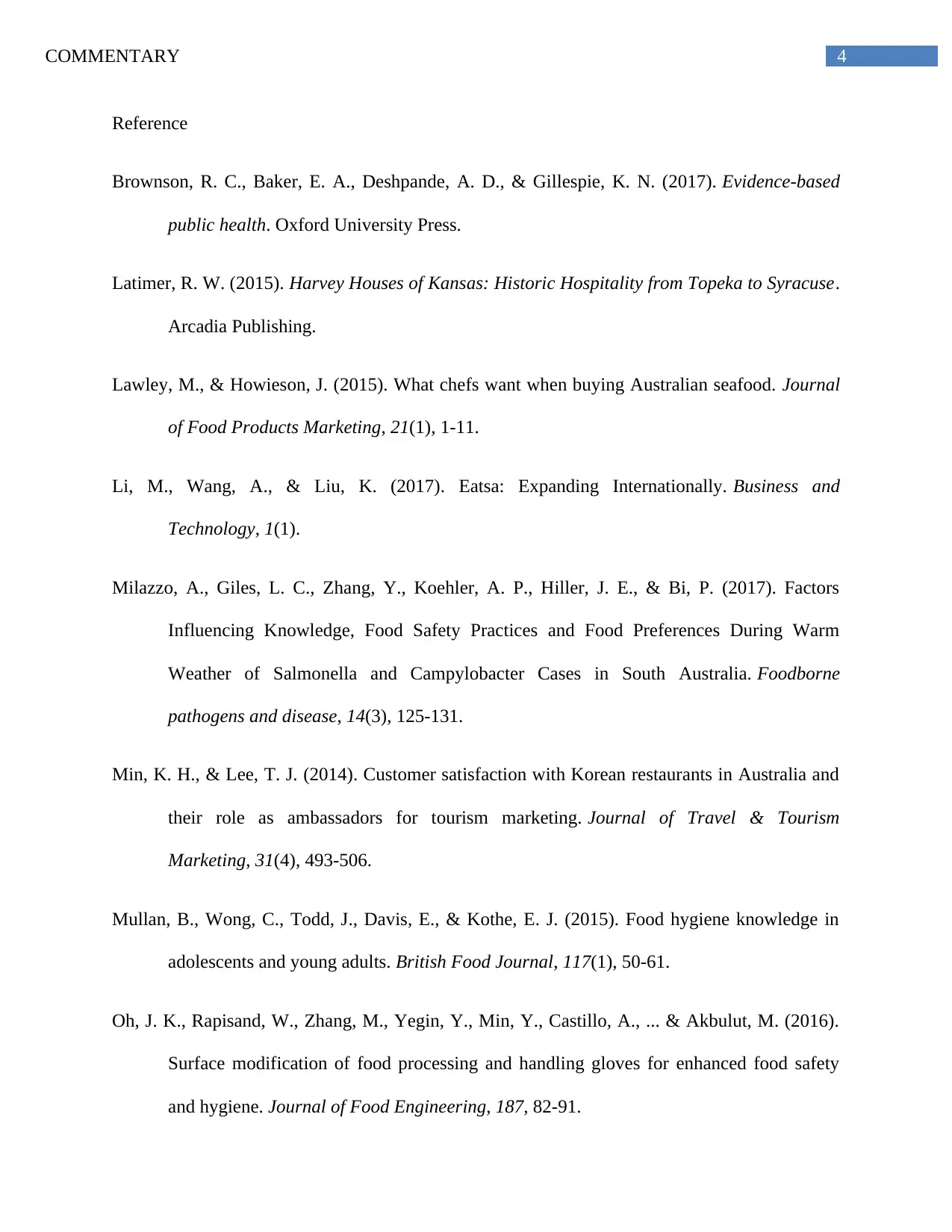
4COMMENTARY
Reference
Brownson, R. C., Baker, E. A., Deshpande, A. D., & Gillespie, K. N. (2017). Evidence-based
public health. Oxford University Press.
Latimer, R. W. (2015). Harvey Houses of Kansas: Historic Hospitality from Topeka to Syracuse.
Arcadia Publishing.
Lawley, M., & Howieson, J. (2015). What chefs want when buying Australian seafood. Journal
of Food Products Marketing, 21(1), 1-11.
Li, M., Wang, A., & Liu, K. (2017). Eatsa: Expanding Internationally. Business and
Technology, 1(1).
Milazzo, A., Giles, L. C., Zhang, Y., Koehler, A. P., Hiller, J. E., & Bi, P. (2017). Factors
Influencing Knowledge, Food Safety Practices and Food Preferences During Warm
Weather of Salmonella and Campylobacter Cases in South Australia. Foodborne
pathogens and disease, 14(3), 125-131.
Min, K. H., & Lee, T. J. (2014). Customer satisfaction with Korean restaurants in Australia and
their role as ambassadors for tourism marketing. Journal of Travel & Tourism
Marketing, 31(4), 493-506.
Mullan, B., Wong, C., Todd, J., Davis, E., & Kothe, E. J. (2015). Food hygiene knowledge in
adolescents and young adults. British Food Journal, 117(1), 50-61.
Oh, J. K., Rapisand, W., Zhang, M., Yegin, Y., Min, Y., Castillo, A., ... & Akbulut, M. (2016).
Surface modification of food processing and handling gloves for enhanced food safety
and hygiene. Journal of Food Engineering, 187, 82-91.
Reference
Brownson, R. C., Baker, E. A., Deshpande, A. D., & Gillespie, K. N. (2017). Evidence-based
public health. Oxford University Press.
Latimer, R. W. (2015). Harvey Houses of Kansas: Historic Hospitality from Topeka to Syracuse.
Arcadia Publishing.
Lawley, M., & Howieson, J. (2015). What chefs want when buying Australian seafood. Journal
of Food Products Marketing, 21(1), 1-11.
Li, M., Wang, A., & Liu, K. (2017). Eatsa: Expanding Internationally. Business and
Technology, 1(1).
Milazzo, A., Giles, L. C., Zhang, Y., Koehler, A. P., Hiller, J. E., & Bi, P. (2017). Factors
Influencing Knowledge, Food Safety Practices and Food Preferences During Warm
Weather of Salmonella and Campylobacter Cases in South Australia. Foodborne
pathogens and disease, 14(3), 125-131.
Min, K. H., & Lee, T. J. (2014). Customer satisfaction with Korean restaurants in Australia and
their role as ambassadors for tourism marketing. Journal of Travel & Tourism
Marketing, 31(4), 493-506.
Mullan, B., Wong, C., Todd, J., Davis, E., & Kothe, E. J. (2015). Food hygiene knowledge in
adolescents and young adults. British Food Journal, 117(1), 50-61.
Oh, J. K., Rapisand, W., Zhang, M., Yegin, Y., Min, Y., Castillo, A., ... & Akbulut, M. (2016).
Surface modification of food processing and handling gloves for enhanced food safety
and hygiene. Journal of Food Engineering, 187, 82-91.
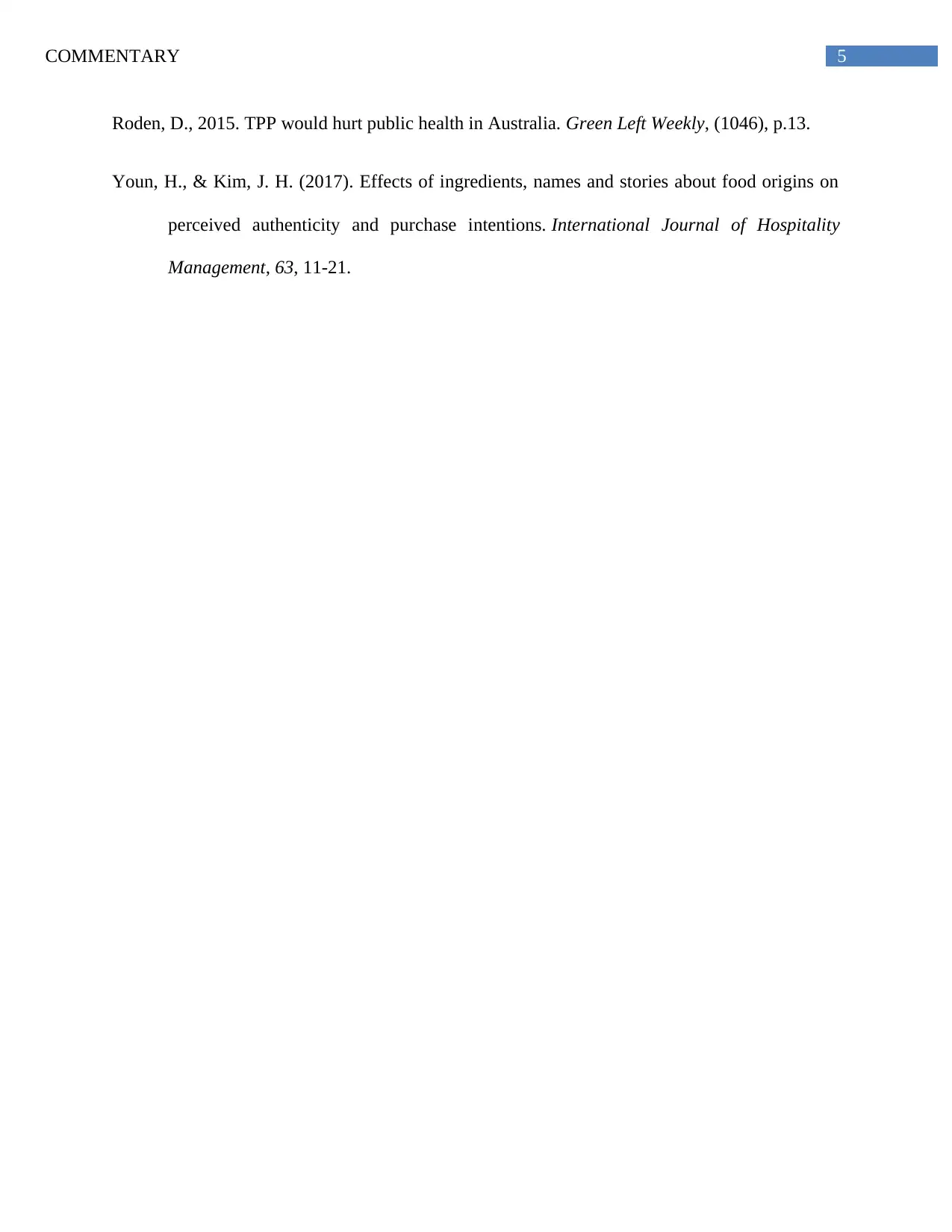
5COMMENTARY
Roden, D., 2015. TPP would hurt public health in Australia. Green Left Weekly, (1046), p.13.
Youn, H., & Kim, J. H. (2017). Effects of ingredients, names and stories about food origins on
perceived authenticity and purchase intentions. International Journal of Hospitality
Management, 63, 11-21.
Roden, D., 2015. TPP would hurt public health in Australia. Green Left Weekly, (1046), p.13.
Youn, H., & Kim, J. H. (2017). Effects of ingredients, names and stories about food origins on
perceived authenticity and purchase intentions. International Journal of Hospitality
Management, 63, 11-21.
⊘ This is a preview!⊘
Do you want full access?
Subscribe today to unlock all pages.

Trusted by 1+ million students worldwide
1 out of 6
Related Documents
Your All-in-One AI-Powered Toolkit for Academic Success.
+13062052269
info@desklib.com
Available 24*7 on WhatsApp / Email
![[object Object]](/_next/static/media/star-bottom.7253800d.svg)
Unlock your academic potential
Copyright © 2020–2025 A2Z Services. All Rights Reserved. Developed and managed by ZUCOL.



